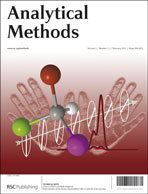Determination of total arsenic, chromium, copper and manganese in hot spring waters containing highly complex matrices and interferences by electrothermal atomic absorption spectrometry (ETAAS) was carried out in the presence of Ni, Pd, Ni + Pd and Ni + Pd + citric acid (CA) as chemical modifiers. Pyrolysis and atomization temperatures of analytes in sample and aqueous standard solutions, atomization and background profiles of analytes in sample solutions were obtained with and without modifiers and compared with each other. Effects of mass and mass ratio of modifiers were also studied. Limit of detection (LOD), limit of quantification (LOQ) and characteristic masses (mo) of analytes were found in the presence and absence of modifiers. Among the tested modifier mixtures, the Ni + Pd + CA modifier mixture was found to be preferable for the determination of analytes. The lowest LOD and mo values obtained with Ni + Pd + CA were 0.8 μg L−1 and 32 pg for As, 0.5 μg L−1 and 5.0 pg for Cr, 0.6 μg L−1 and 18 pg for Cu and 0.4 μg L−1 and 4 pg for Mn, respectively. The percent relative error found was below 5% for the determination of the analytes by the proposed method in the certified reference materials (CRMs) of water (Spsww-1 and 1643e). Arsenic in CRMs and sample solutions was also determined by hydride generation atomic absorption spectrometry (HGAAS) for the purpose of comparing with As results obtained by ETAAS. Results of analytes in sample solutions were compared with national and international water quality guidelines such as WHO and US EPA values, as well as literature data.

You have access to this article
 Please wait while we load your content...
Something went wrong. Try again?
Please wait while we load your content...
Something went wrong. Try again?


 Please wait while we load your content...
Please wait while we load your content...